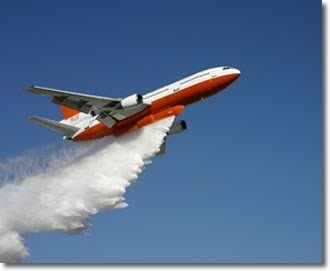The National Transportation Safety Board has released their official report on the DC-10 air tanker tree-strike incident that occurred in June of 2007. This was a closer call than we realized. The aircraft struck 13 trees, one of which was only 45-feet tall. This may explain some of the reluctance of the U.S. Forest Service to award a contract to Evergreen's 747 air tanker.
A huge jet-powered airliner maneuvering slowly a few hundred feet above mountainous terrain near convection columns does not have many options when encountering unexpected turbulence. If they need to gain altitude quickly, it takes a while for the jet engines to spool up after applying more throttle.
We told you on Wildfire Today about the study that NASA will be conducting for the USFS about the suitability of DC-10's and 747's for use as air tankers.
Here is an excerpt from the report. The entire document is HERE.
On June 25, 2007, about 1720 Pacific daylight time, a McDonnell Douglas DC 10-10, N450AX (Tanker 910), impacted trees with the left wing during a fire suppression flight in support of the White Fire about 12 miles southwest of Tehachapi, California. The airplane was owned by BC Aircraft Leasing LLC, and leased to 10 Tanker Air Carrier, LLC. The California Department of Forestry and Fire Prevention (Cal Fire) was operating the airplane as a public use flight. The captain, first officer (FO), and flight engineer (FE), were not injured. The airplane was substantially damaged. Visual meteorological conditions prevailed, and Cal Fire flight tracking procedures were in effect. The airplane departed Southern California Logistics Airport, Victorville, California, at 1657.
According to Cal Fire personnel, the flight crew was preparing to jettison a load of retardant. While turning on final for the drop, the left wing impacted several trees. The flight crew climbed the airplane to 11,000 feet where they jettisoned the fire retardant. Then, they landed uneventfully at their departure airport at 1748.
Cal Fire had contracted with 10 Tanker Air Carrier, LLC to provide and operate the accident airplane. The airplane was to be operated on an exclusive use contract for wildland fire protection.
Thirteen impacted trees were identified by Cal Fire personnel. The first identified tree that sustained impact was 45 feet tall at a base elevation of 7,786 feet mean sea level (msl). (emphasis added)
Personnel Statements
The flight crew submitted written statements regarding the accident. In summary, they indicated that they were conducting the third drop of the day. After joining with the lead airplane on the downwind leg for the retardant drop, they descended to about 7,700 feet msl. The run was set for a slight descent down the line of fire on a ridge. As they turned from base leg to final leg in a left turn of approximately 30 degrees, the airplane developed a sink rate, and the flight crew heard several thump sounds. The Captain verbalized the problem, advanced the throttles, and rolled the airplane's wings level. The Flight Engineer scanned the wing and noted damage to the left wing aileron, slat, and flap. The flight climbed and continued to a non-populated area with the lead airplane in trail. The fire retardant was jettisoned, the flight crew declared an emergency, and then they flew to Victorville where they landed uneventfully.





No comments:
Post a Comment